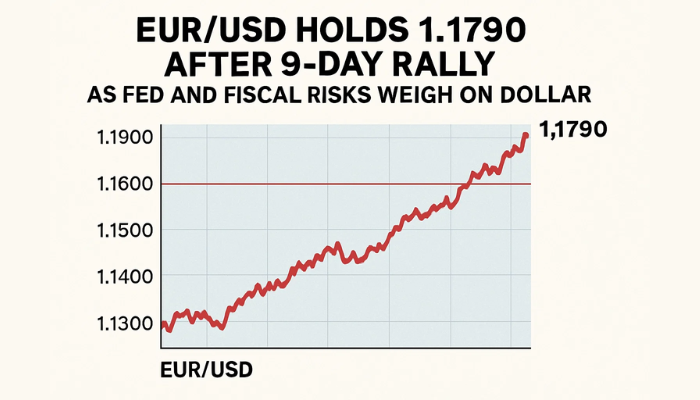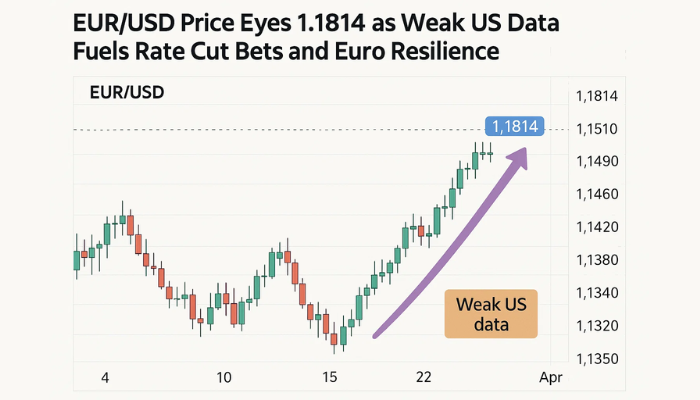Prices Forecast: Technical Analysis
For the EUR/USD, the daily closing price is predicted to be around 1.1750, with a range between 1.1700 and 1.1800. The weekly closing price is expected to be approximately 1.1780, with a range from 1.1700 to 1.1900. The RSI is currently at 67.1582, indicating a bullish trend, but nearing overbought territory. The ATR at 0.0091 suggests moderate volatility, while the ADX at 27.6657 shows a strengthening trend. The MACD line is above the signal line, reinforcing the bullish sentiment. However, the proximity to resistance levels and the pivot point at 1.18 suggests caution. Traders should watch for potential reversals if the price approaches the upper resistance levels.
Fundamental Overview and Analysis
Recently, EUR/USD has shown a bullish trend, driven by positive economic indicators from the Eurozone, such as the HCOB Services PMI. The asset’s value is influenced by macroeconomic factors, including the US Non-Farm Payrolls and unemployment data, which impact the USD. Investor sentiment remains cautiously optimistic, with potential growth opportunities tied to Eurozone economic recovery. However, risks include US economic resilience and potential interest rate changes. The current valuation appears fair, with the EUR/USD trading near its pivot point. Market participants are closely monitoring economic data releases for further direction.
Outlook for EUR/USD
The future outlook for EUR/USD suggests a continuation of the current bullish trend, supported by positive Eurozone economic data. Short-term price movements (1 to 6 months) are expected to remain within the 1.1700 to 1.1900 range, influenced by economic conditions and central bank policies. Long-term forecasts (1 to 5 years) depend on geopolitical stability and economic growth in the Eurozone. External factors such as US economic performance and global trade dynamics could significantly impact the asset’s price. Investors should remain vigilant for any shifts in economic indicators or policy changes that could alter the current trend.
Technical Analysis
Current Price Overview: The current price of EUR/USD is 1.1750, slightly above the previous close of 1.175. Over the last 24 hours, the price has shown a slight upward trend with moderate volatility. Support and Resistance Levels: Key support levels are at 1.17, 1.17, and 1.16, while resistance levels are at 1.18, 1.19, and 1.19. The pivot point is at 1.18, with the asset trading slightly below it, indicating potential resistance. Technical Indicators Analysis: The RSI at 67.1582 suggests a bullish trend, while the ATR at 0.0091 indicates moderate volatility. The ADX at 27.6657 shows a strengthening trend. The 50-day SMA and 200-day EMA do not indicate a crossover, suggesting a stable trend. Market Sentiment & Outlook: Sentiment is currently bullish, supported by price action near the pivot, RSI direction, and ADX strength. However, traders should be cautious of potential reversals near resistance levels.
Forecasting Returns: $1,000 Across Market Conditions
Investors considering a $1,000 investment in EUR/USD should be aware of potential market scenarios. In a Bullish Breakout scenario, a price increase of +5% could result in an estimated value of ~$1,050. In a Sideways Range scenario, with minimal price change, the investment might remain around ~$1,000. In a Bearish Dip scenario, a price decrease of -5% could reduce the investment to ~$950. These scenarios highlight the importance of understanding market conditions and potential price movements. Investors should consider their risk tolerance and market outlook when making investment decisions.
| Scenario | Price Change | Value After 1 Month |
|---|---|---|
| Bullish Breakout | +5% to ~$1,233 | ~$1,050 |
| Sideways Range | 0% to ~$1,175 | ~$1,000 |
| Bearish Dip | -5% to ~$1,116 | ~$950 |
FAQs
What are the predicted price forecasts for the asset?
The daily closing price for EUR/USD is predicted to be around 1.1750, with a range between 1.1700 and 1.1800. The weekly closing price is expected to be approximately 1.1780, with a range from 1.1700 to 1.1900.
What are the key support and resistance levels for the asset?
Key support levels for EUR/USD are at 1.17, 1.17, and 1.16, while resistance levels are at 1.18, 1.19, and 1.19. The pivot point is at 1.18, with the asset trading slightly below it.
Disclaimer
In conclusion, while the analysis provides a structured outlook on the asset’s potential price movements, it is essential to remember that financial markets are inherently unpredictable. Conducting thorough research and staying informed about market trends and economic indicators is crucial for making informed investment decisions.



